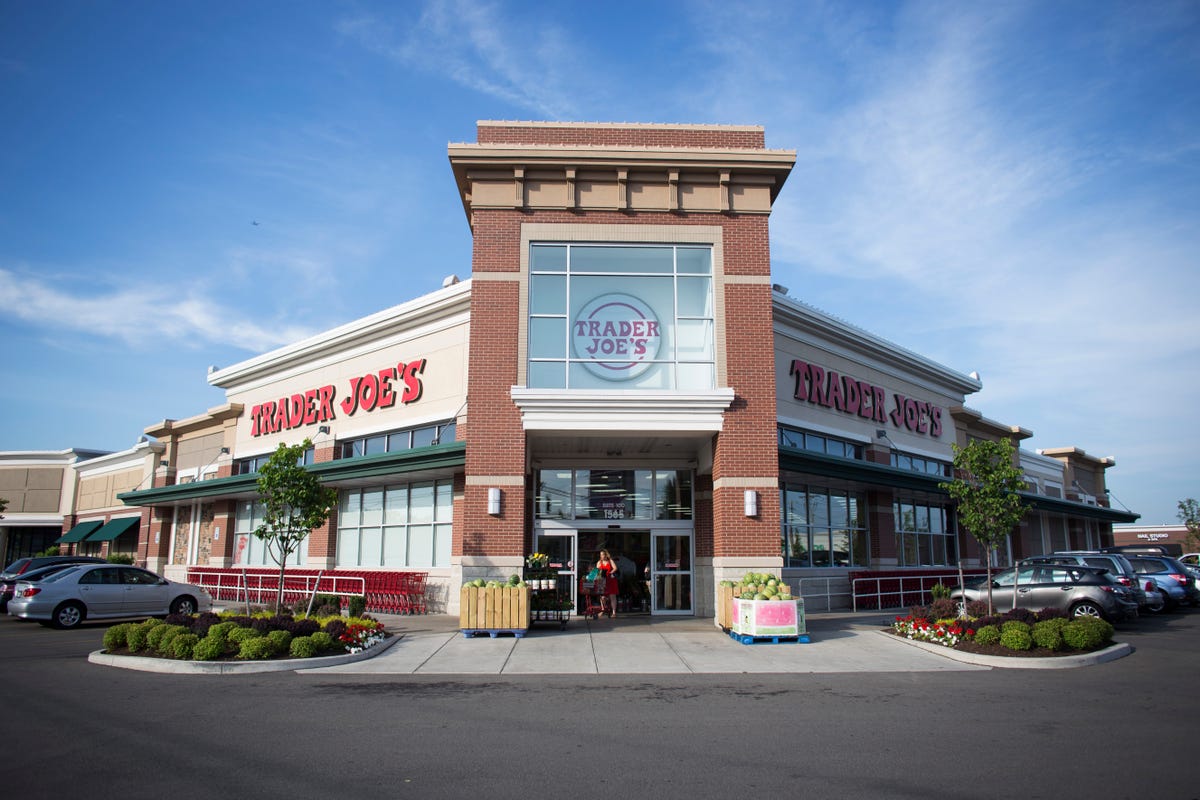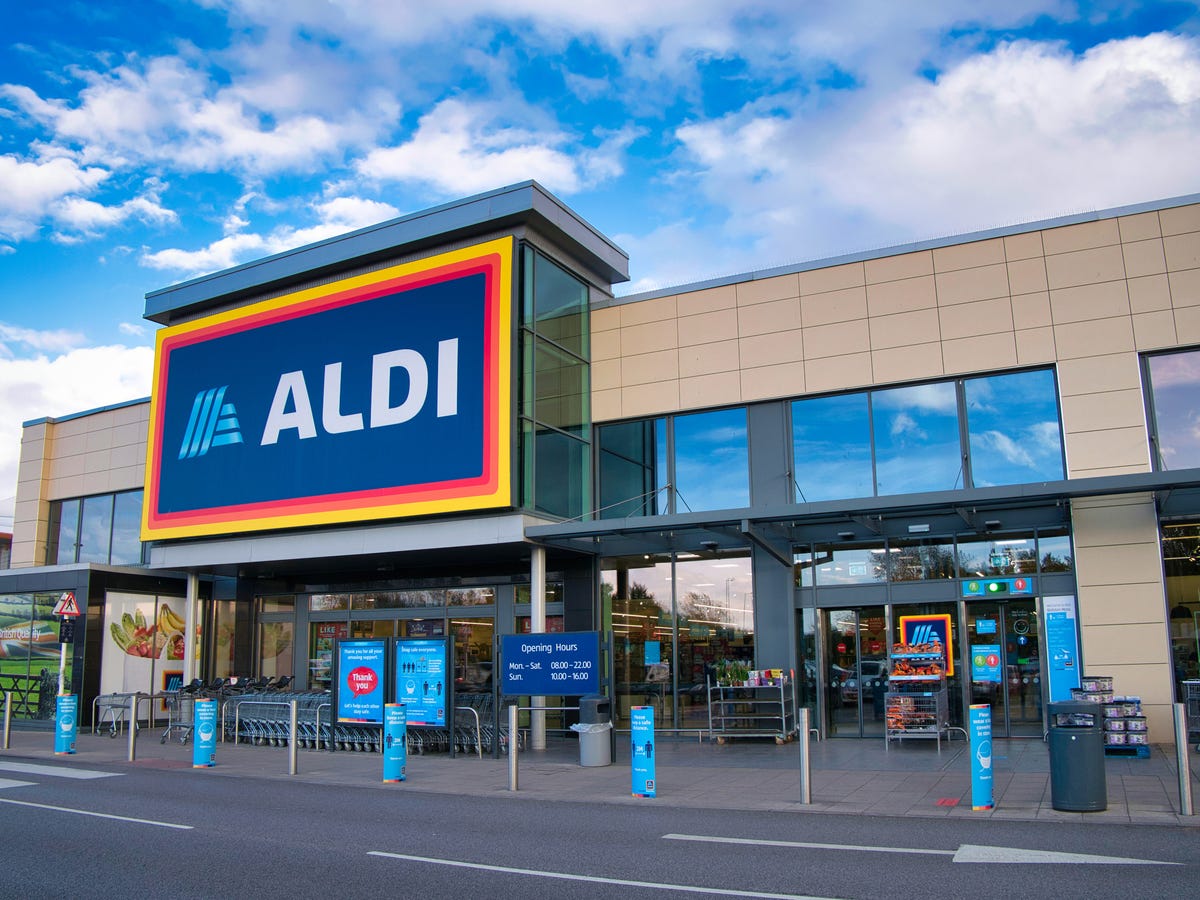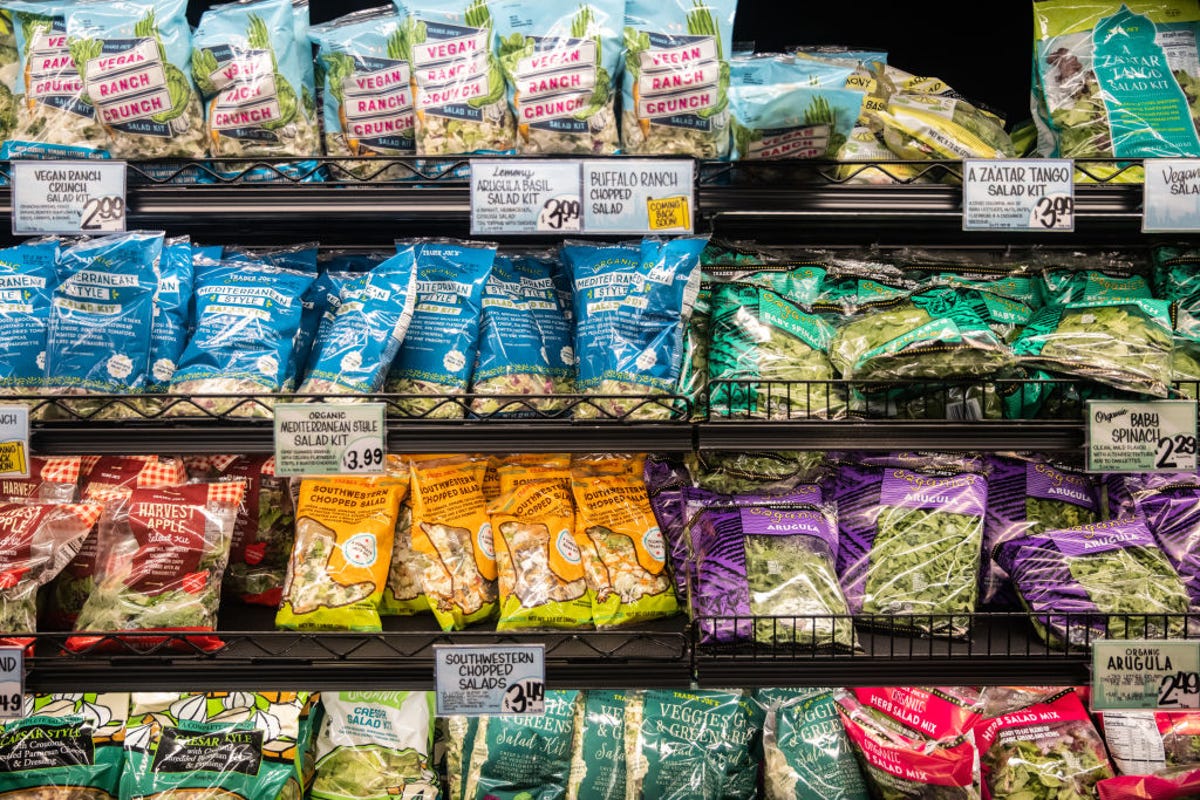Trader Joe’s and Aldi are two of the most beloved supermarkets, with shoppers singing their praises for having unique items and lower prices than other stores. Both chains score high marks among shoppers. In fact, a YouGov poll last year listed Trader Joe’s as the third most popular and Aldi as fifth.
Before we dive in, note that while Aldi and Trader Joe’s operate independently and with slightly different approaches, they’ve both been owned by the Albrecht family since 1979. (Hustle recognizes hustle.) Looking for even more ways to cut costs at the supermarket? We found the cheapest grocery delivery service for 2024 and did more math to see how much you can save buying in bulk at Costco for a year.
How I compared prices for Trader Joe’s and Aldi

Trader Joe’s might have better name recognition, but Aldi ranks higher in “popularity,” according to a YouGov poll.
To calculate the price difference between Trader Joe’s and Aldi, I first generated a list of about 40 basic grocery items representing a wide range of prices from nearly all food departments — from fresh produce to pantry goods to frozen items. While both retailers also carry bath, body and cleaning supplies, my primary interest was the cost of food, so those departments were left out of my analysis.
I sourced item prices in person from Trader Joe’s and Aldi stores in the greater New York City. I looked for equivalent products both in terms of quality and portion size, and I made a note if one store offered a larger size. The prices were not scaled accordingly, however, since I wanted the total to reflect what you might actually find on your grocery receipts.
Trader Joe’s vs. Aldi
| Product | TJs | Aldi |
|---|---|---|
| Baby spinach, 6 oz.^ | $1.99 | $1.79 |
| Fresh herbs (variety), 1 oz.* | $1.69 | $0.85 |
| Head of cauliflower, each | $2.99 | $3.29 |
| Red bell pepper, each^ | $1.29 | $2.69 |
| Banana, each | $0.19 | $0.27 |
| Beefsteak tomato, each^ | $1.29 | $2.89 |
| Italian extra virgin olive oil, 33.8 oz.* | $5.99 | $8.29 |
| Honey O’s, 13.5 oz. | $2.29 | $1.59 |
| Organic unsweetened soy beverage, 32 oz. | $1.99 | $2.19 |
| Classic potato chips, 10 oz.* | $2.49 | $1.99 |
| Tortilla chips, 10 oz.^ | $2.49 | $2.29 |
| Roasted red pepper hummus, 10 oz. | $3.49 | $2.45 |
| Shredded mild cheddar cheese, 12 oz.* | $3.49 | $3.79 |
| Cream cheese, 8 oz. | $1.69 | $1.59 |
| Sliced muenster cheese, 12 oz.* | $4.49 | $1.99 |
| Greek nonfat yogurt, 32 oz. | $5.49 | $3.69 |
| Organic 2% milk, half gallon | $3.79 | $3.79 |
| Unsweetened applesauce, 24 oz. | $1.99 | $1.95 |
| Creamy salted peanut butter, 16 oz.^ | $2.29 | $1.79 |
| Whole bean coffee, 14 oz.* | $4.99 | $4.89 |
| Whole roasted and salted cashews, 16 oz. | $7.99 | $12.79 |
| Organic low sodium chicken broth, 32 oz. | $1.99 | $1.89 |
| Garbanzo beans, 15 oz. | $0.89 | $0.79 |
| Black beans, 15 oz. | $0.89 | $0.86 |
| Dijon mustard, 12.3 oz. | $1.99 | $1.09 |
| Grade A 100% maple syrup, 8 oz. | $4.49 | $7.09 |
| Spaghetti, 16 oz. | $0.99 | $1.39 |
| Unbleached all-purpose flour, 5lbs | $2.99 | $2.19 |
| Frozen peas, 16 oz.* | $1.59 | $0.85 |
| Frozen pepperoni pizza, 15.5 oz. | $5.99 | $3.59 |
| Multigrain waffles, 11 oz.^ | $2.49 | $1.99 |
| Large brown eggs, 1 dozen | $3.29 | $3.29 |
| Cheese tortellini, 10 oz.* | $2.49 | $1.85 |
| 15% lean ground beef, 16 oz. | $5.99 | $4.29 |
| Fresh Atlantic salmon, 16 oz. | $9.99 | $9.99 |
| Ground turkey, 16 oz.^ | $3.99 | $5.19 |
| All natural whole chicken, per pound | $3.99 | $1.99 |
| Plain bagels, 6 count, 18 oz. | $1.99 | $1.99 |
| English muffins, 6 count, 12 oz. | $1.99 | $1.39 |
| Flour tortillas, 8 count, 15.5 oz. | $2.99 | $1.95 |
| French vanilla ice cream, half gallon | $6.49 | $5.99 |
| Total | $131.89 | $126.50 |
| *indicates that Trader Joe’s item was of a larger size | ||
| ^indicates that Aldi item was of a larger size |
Verdict: Aldi and Trader Joe’s cost about the same
The grand totals for the list of more than 40 items from each store came within about $5 of each other — a difference of less than 4% between stores (compare that to the almost 35% difference I calculated between Trader Joe’s and a conventional retailer). Aldi did have a slight advantage in overall prices, coming in around $127 for the full list compared to Trader Joe’s $132. That being said, if you have to choose between Aldi or Trader Joe’s, it should really come down to which store is more convenient or closer to where you live.
Where you’ll find the biggest savings at Aldi and Trader Joe’s

Aldi and Trader Joe’s almost broke even in a price comparison of popular grocery items.
Despite having similar prices, there are some takeaways in terms of which store has better deals on specific items. Also, depending on your shopping needs, you might find one store more consistently priced than the other.
Trader Joe’s and Aldi were fairly aligned with respect to most pantry and meat products, and the winner of the lowest price seesawed from item to item. The big exception is that Trader Joe’s seems untouchable when it comes to discount prices on coffee, oils and nuts. (Who exactly is Joe trading with? The devil?)
For dairy, I give Aldi the overall advantage, with equal or lower prices on nearly every item in that category. While Trader Joe’s does have some favorable prices for “fancy” cheese, TJ’s can’t seem to make a better deal on everyday shreds and slices. (Cheese was the category where Trader Joe’s lost out to Stop & Shop.) Aldi was also at an advantage for produce items that were priced individually, though its produce department is significantly smaller than TJ’s. Plus, certain items such as beefsteak tomatoes and bell peppers were only available at Aldi’s in two- or three-packs, bringing the overall cost of goods in that department up due to the larger size.
How do Trader Joe’s and Aldi keep prices low?

Trader Joe’s and Aldi have won customers over with more than just low prices.
Turns out that there’s more to the “trader” element of Trader Joe’s than a catchy name. According to the Trader Joe’s website, the grocer deals directly with manufacturers and growers instead of with brokers and distributors, which is the norm for most American grocery chains. Cutting out that middle tier is part of the reason TJ’s is able to offer products at such consistently low prices. But Trader Joe’s isn’t the only, nor the first, company to operate that way.
Aldi, a grocery retailer based in Germany that slightly predates Trader Joe’s, has stores across Europe and the US. The chain works directly with producers, using over 50 different “brand” labels that are essentially Aldi store brands, such as Baker’s Corner, Dakota’s Pride and Kirkwood, among many others. (Kirkwood sounds similar to bulk retailer Costco’s proprietary Kirkland brand, but Aldi predates Costco by a couple of decades.) Aldi carries a few name-brand products, as does Trader Joe’s, but those represent less than 10% of either store’s offerings. Keeping a limited number of Stock Keeping Units, or SKUs used for inventory management, is one way both companies are able to pass savings along to customers.
Aldi also operates as more of a low-overhead retailer than Trader Joe’s, with a feel similar to Costco or other discount bulk stores. There are few bells and whistles to Aldi’s aisles, and the vibe is more perfunctory and spare, with items stacked on shelves in their shipping boxes, which results in less labor required to restock. You won’t find hand-drawn signs to indicate Aldi prices, nor will you find a plethora of helpful staff or free samples like you would at TJ’s.
Though this battle of the bargain retailers didn’t turn up a clear winner between Trader Joe’s and Aldi, if you live someplace where you can choose either store, the winner is you.
Editor’s note: This analysis was performed in February 2023. Prices may have changes since then.




















+ There are no comments
Add yours